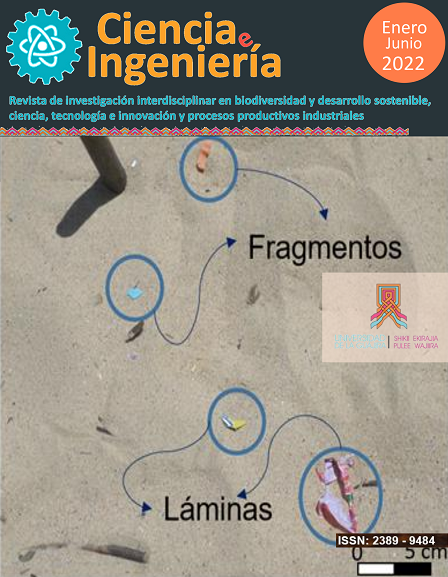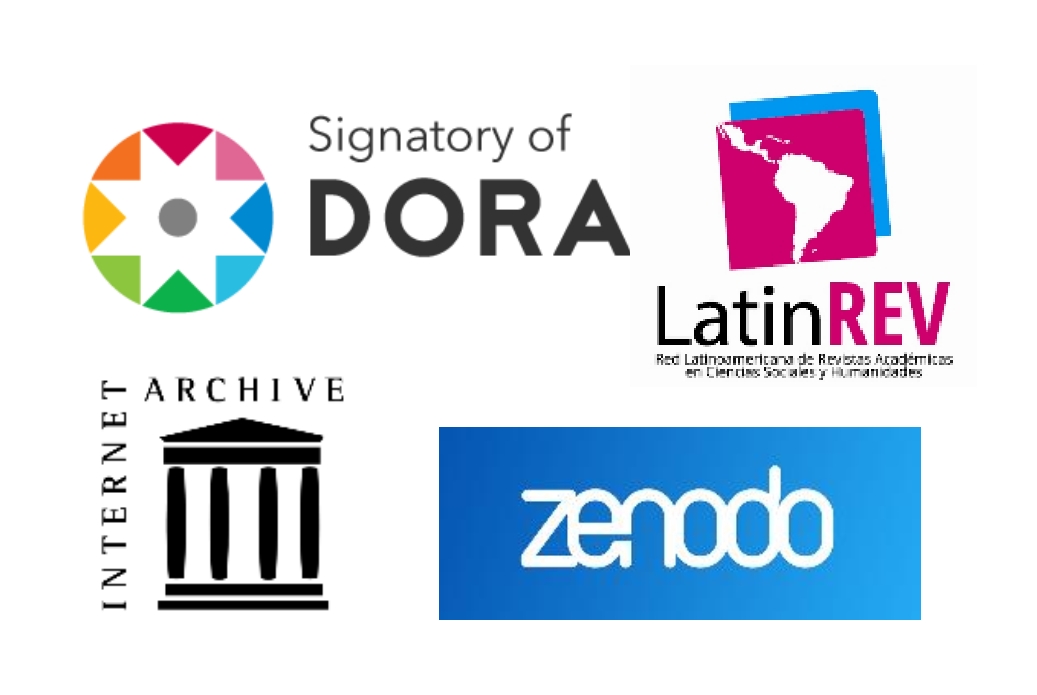Some Ecological Interactions of Polyquets in the Colombian Caribbean Sea: Review
DOI:
https://doi.org/10.5281/zenodo.6658595Keywords:
annelida, association, bentos, diversityAbstract
Polychaetes are worms mainly characterized by the presence of setae on their bodies, sensory organs in the protostomium and peristomium, and in some groups, filamentous plumes that help filter organic matter suspended in the water; The most notable importance of polychaetes is that they reflect different degrees of contamination in the ecosystem. The present work shows a review of multiple documents that show some commensal, parasitic, mutualistic interactions and their relationship polychaetes-physicochemical variables in the Colombian Caribbean Sea in order to know the information gaps present in the group and to be able to generate knowledge from these. Information is collected from multiple journals such as Acta Biológica Colombiana of the National University of Colombia and databases such as the Juan Roa library of the Universidad del Bosque. It was found that polychaetes have a tendency to prefer organisms of the same taxonomic group, the best known are among the cnidarians, porifera and echinoderms as well as commensalists, parasites or mutualists, representing a little more than 290 species with this interaction. In conclusion, the fact that this group should be much more studied in order to continue enriching the diversity of our country and knowing its fauna is evident.
Downloads
References
Arteaga-Flórez, C., & Londoño-Mesa, M. H. (2015). Nereidids (nereididae, polychaeta, annelida) associated to red mangrove roots, rhizophora mangle, in san andrés and old providence islands, colombian caribbean. Boletín de Investigaciones Marinas y Costeras - INVEMAR, 44(1), 163–184.
Báez, D. Ardila, N. (2003). Poliquetos (Annelida: Polychaeta) del Mar Caribe Colombiano. Biota Colomb. 4(1): 89-109.
Dauwe, B., PMJ Herman, CHR Heip. (1998). Estructura comunitaria y potencial de bioturbación de la macrofauna en cuatro estaciones del Mar del Norte con suministro de alimentos contrastante. Mar. Ecol. Prog. Ser. 173: 67-83.
Dean, H. (2012). A literature review of the Polychaeta of the Caribbean Sea. Zootaxa 3596: 1-86.
Dias, O. Lieñero L. (2009). Porcentaje del grado de infestación de polydora cf. websteri hartman, 1943 (polychaeta: spionidae) por clase de talla de crassostrea rhizhophorae (guilding, 1828) de la laguna la restinga (isla margarita, Venezuela). Rev. Cient. (Maracaibo) 19, 2 113-118
Dimock Jr, R. V., & Dimock, J. G. (1969). A possible “defense” response in a commensal polychaete. Veliger, 12, 65–68.
Dueñas-Ramírez, P. R., & Dueñas-Lagos, A. C. (2016). Primer registro de Branchiomma coheni (Polychaeta: Sabellidae) en las costas del Caribe colombiano. Journal of Marine and Coastal Sciences, 101–105. https://doi.org/10.15359/revmar.8-2.7
Fernández-Rodríguez, V., & Londoño-Mesa, M. H. (2015). Poliquetos (Anelida: Polychaeta) como indicadores biológicos de contaminación marina: casos en Colombia. Gestión y Ambiente, 18(1), 189-204.
Fernández-Rodríguez, V., Londoño-Mesa, M. H., & Ramírez-Restrepo, J. J. (2016). Polychaetes from red mangrove (rhizophora mangle) and their relationship with the water conditions in the gulf of urabá, colombian caribbean. Acta Biológica Colombiana, 21(3), 611–618. https://doi.org/10.15446/abc.v21n3.50796
Fonseca A. (2000). Caracterización preliminar del bentos de la ensenada de Tumaco, para el período junio octubre de 2000. Journal Contribution 36-4
García-Valencia, C. (2007). Atlas del Golfo de Urabá: Una mirada al Caribe de Antioquia y Chocó. Invemar.
Gómez-Maduro, M. C., & Díaz-Díaz, O. (2017). Association between the polynoid Malmgreniella variegata (Polychaeta: Polynoidae) and Ophionereis reticulata (Ophiuroidea: Ophionereididae) first record to the Southeastern Caribbean. Revista de Biología Tropical, 65(1–1), S85–S91.
Guzmán A., Lattig p., y Ruiz J. (2006). Caracterización espacial y temporal de los poliquetos de fondos blandos en una bahía tropical (CARIBE COLOMBIANO). Bol. Invertir. Mar. Costo. vol.35 no.1 19-36
Handley, S.J. (2002). Optimizing intertidal Pacific oyster (Crassostrea gigas Thunberg) culture, Houhora Harbour, northern New Zealand. Aquaculture Research, 33: 1019-1030.
Hoeksema, B. W., & Harry, A. (2017). The invasive sun coral Tubastraea coccinea hosting a native Christmas tree worm at Curaçao, Dutch Caribbean. Marine Biodiversity, 47(1), 59–65.
Lattig, P., & Martin, D. (2011). Sponge-associated Haplosyllis (Polychaeta: Syllidae: Syllinae) from the Caribbean Sea, with the description of four new species. Scientia Marina, 75(4), 733–758.
Londoño-Mesa, M., Polanía, J., & Vélez, I. (2002). Polychaetes of the mangrove-fouling community at the Colombian Archipelago of San Andres and Old Providence, Western Caribbean. Wetlands Ecology and Management, 10(3), 227–232. https://doi.org/10.1023/A:1020127814042
López, E., Britayev, T. A., Martin, D., & San Martín, G. (2001). New symbiotic associations involving Syllidae (Annelida: Polychaetae), with taxonomic and biological remarks on Pionosyllis magnifica and Syllis cf armillaris. Journal of the Marine Biological Association of the UK 81(03):399 - 409
López, T., Santodomingo, N., & Reyes, J. (2008). Presence of calcareous biogenic tubes on coral madracis myriaster structure (scleractinia: pocilloporidae) from deep-water in colombian caribbean. Boletín de Investigaciones Marinas y Costeras - INVEMAR, 37(2), 227–233.
Martin, D., & Britayev, T. A. (1998). Symbiotic polychaetes: Review of known species. Oceanogr. Mar. Biol.: An Ann. Rev. 36: 217-340
Miller, W., & Wolf, M. (2008). Crawling with Worms: A look at two symbiotic relationships between polycheates and urchins from the Bahamas.
Montebon ARF, Yap HT (2009) Abundance, density, and size structure of Spirobranchus gaymardi (Polychaeta, Serpulidae) in Philippine coral reefs. Bull Mar Sci 84:93–108
Murad-B. M., M. 1976. Relationship between biofouling and growth of the pearl oyster pinctada fucata (Gould) in Kuwait, Arabian Gulf. Hydrobiologia, 15: 129-138.
Neumann, C. (1966) . Observations on coastal erosion in Bermuda and measurements of the boring rate of the sponge Cliona lampa. Limnology and Oceanography, 11: 92-108.
Palacio J. (1978). Variación de la fauna de invertebrados del área estuárica de la Ciénaga Grande de Santa Marta en relación con los cambios de salinidad. Anales del Instituto de Investigaciones Marinas de Punta Betín, 10: 111-126.
Por, Z., Domènech, R., Martinell, J., & Porta, J. (2008). Bioerosión por poliquetos espiónidos (Polychaeta, Spionidae) en moluscos marinos del Cuaternario caribeño de Colombia. Rev. Acad. Colomb. Cienc., 32. (124): 411-419
Posey, M. H., T. D. Alphinn, L. Cahoon. 2006. Benthic community responses to nutrient enrichment and predator exclusion: Influence of background nutrient concentration and interactive effects. Journal of Experimental Marine Biology and Ecology 330: 105-118
Reyes, R., & C, N. H. C. (1992). Moluscos; anélidos y crustáceos asociados a las raíces de Rhizophora mangle Linnaeus, en la región de Santa Marta, caribe colombiano. Caldasia, 17(1), 133–148.
Rios, B. (2019). Establecimiento de relaciones simbióticas en poliquetos del mar caribe. Bol. Inst. Oceanogr. Venezuela 58(1): 09-28
Rios, V. Gómez, V. Díaz O. (2014). Syllidae (annelida: polychaeta) asociados a tedania ignis (porifera: tedaniidae) en laguna la restinga, isla margarita, venezuela. Bol. Inst. Oceanogr. Venezuela, 53 (2): 235-240 (2014) 2
Roberts, J. M. (2005). Reef-aggregating behaviour by symbiotic eunicid polychaetes from cold-water corals: Do worms assemble reefs? Marine Biological Association of the United Kingdom. Journal of the Marine Biological Association of the United Kingdom, 85(4), 813.
Rodríguez, H. (1988). Contribución al conocimiento de los anélidos (Annelida: Polychaeta) de aguas someras en la bahía de Nenguange Parque Nacional Natural Tayrona, Colombia. Trianea, 2: 403-443.
Romero P., & J. Polanía. 2008. Sucesión temprana de la taxocenosis Mollusca-Annelida-Crustacea en raíces sumergidas de mangle rojo en San Andrés Isla, Caribe colombiano. Revista de biología marina y oceanografía, 43(1), 63–74.
Romero-Murillo, P. E., & Polanía, J. (2008). Sucesión temprana de la taxocenosis Mollusca-Annelida-Crustacea en raíces sumergidas de mangle rojo en San Andrés Isla, Caribe colombiano. Revista de biología marina y oceanografía, 43(1), 63–74. https://doi.org/10.4067/S0718-19572008000100007
Rowley, S. (2008). A critical evaluation of the symbiotic association between tropical tube-dwelling Polychaetes and their Hermatypic coral hosts, with a focus on Spirobranchus giganteus (Pallas, 1766). The Plymouth Student Scientist, 1(2), pp. 335-353.
Sanchez, T. Trujillo, C. y Barios, E. (2011). Macrobenthic communities associated to soft-bottoms in the southern cost of Taganga bay, Colombian Caribbean during dry season. Rev. Intropica 6, 6 89 - 100
Taylor, P.D. & Wilson, M.A. (2002). A new terminology for marine organisms inhabiting hard substrates. Palaios, 17: 522-525.
Tovar, M., Salazar, P., de León-González, J., Carrera, Luis., Salazar, Sergio I. (2014). Biodiversidad de Polychaeta (Annelida) en México Revista Mexicana de Biodiversidad, 85, 190-196
Van der Meij SET, Fransen CHJM, Pasman LR, Hoeksema BW (2015) Phylogenetic ecology of gall crabs (Cryptochiridae) as associates of mushroom corals (Fungiidae) 5 (24): 5770–5780
Van der Schoot R., Scott C., ten Hove H., Hoeksema B. (2016) Christmas tree worms as epibionts of giant clams at Koh Tao, Gulf of Thailand. Mar Biodivers 46(4):751-752
Vegas, M. (1971). Introducción a la ecología del bentos marino. OEA. Serie biológica. Monografía N 9. Washington, 9: 98-100
Velásquez A. y Evangelista R. (2008). Distribución de poliquetos en la zona intermareal de la playa el Pital, cantón Mizata, departamento de la libertad, El Salvador. Universidad del Salvador.
Villalobos-Guerrero, T. F., & Carrera-Parra, L. F. (2015). Redescription of Alitta succinea (Leuckart, 1847) and reinstatement of A. acutifolia (Ehlers, 1901) n. comb. based upon morphological and molecular data (Polychaeta: Nereididae). Zootaxa, 3919(1), 157–178.
Wargo, R.N. & Ford, S.E. (1993). The Effect of Shell Infestation by Polydora sp. and Infection by Haplosporidium nelsoni (MSX) on the Tissue Condition of Oysters, Crassostrea virginica. Estuaries, 16: 229-234.
Won, Eun-Ji, Sheikh Raisuddin, y Kyung-Hoon Shin. (2008). «Evaluación de la inducción de proteínas similares a la metalotioneína (MTLP) en los poliquetos para el biomonitoreo de la contaminación por metales pesados en sedimentos marinos». Marine pollution bulletin 57, 6-12: 544–551.
Downloads
Published
How to Cite
Issue
Section
License
Copyright (c) 2022 Yofre Guerra G., Geomar Molina B.

This work is licensed under a Creative Commons Attribution-NonCommercial-NoDerivatives 4.0 International License.





